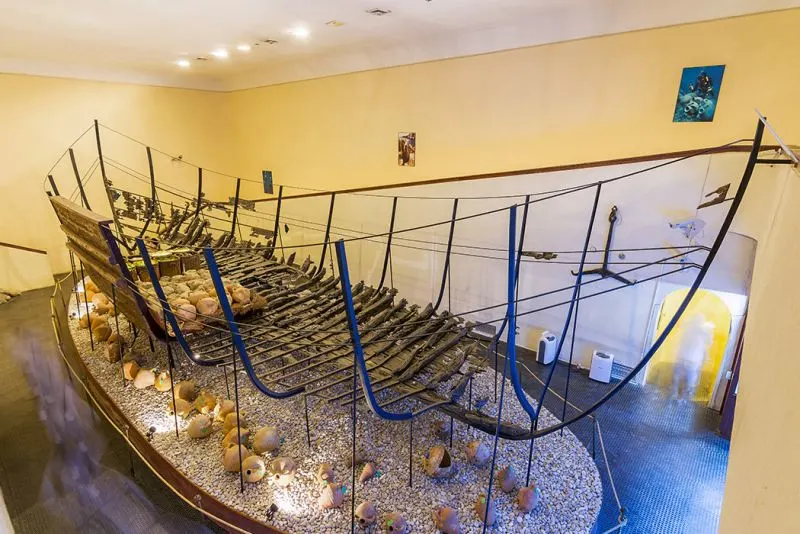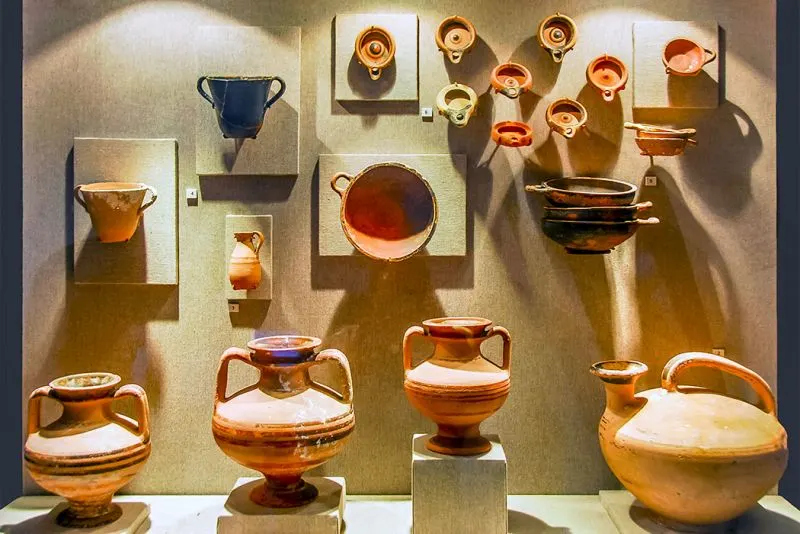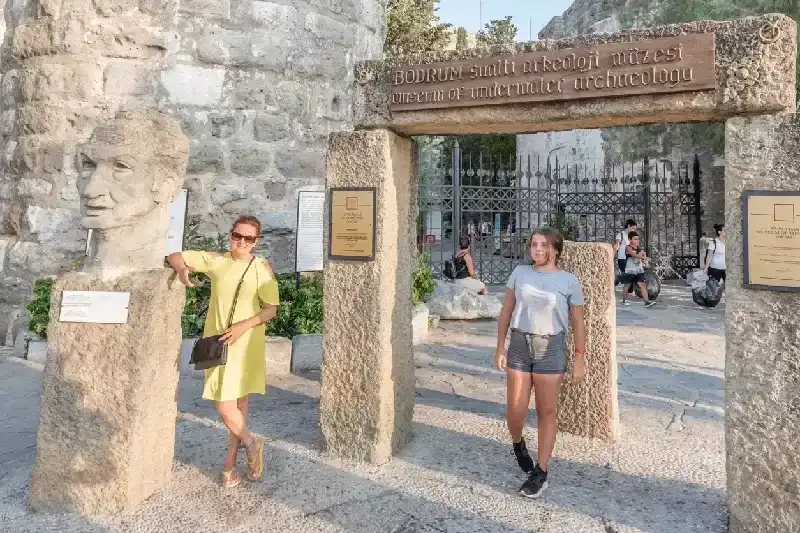Bodrum Museum of Underwater Archaeology of Turkey
Built in Karia, an important region of the antique world, the Bodrum Museum of Underwater Archaeology houses many distinctive underwater finds.

The Bodrum Museum of Underwater Archeology of Turkey was established within the Bodrum Castle in 1964. Originally, reconstruction of the castle was the priority; later, exhibition halls were created within the usable space. Today, there are 14 exhibition halls within the Museum of Bodrum. As is obvious from the name of the museum, it includes mostly underwater artifacts. The Glass Hall, with its ongoing exhibition of glass and glassware, was opened in 1986, with the help of Paşabahçe Glass and Bottle Factory. It’s yet another remarkable destination to add to your Turkey tour experience.
General knowledge about the museum’s glass collection is provided here. The specimens are exhibited darkly, with illumination from below. This method of exhibition permits better viewing of all the varied markings and colors of the glass. Examples dated from the 14th century BC to the 11th century AD are on display. The hall also contains an aquarium, which has been set into an indentation within the wall. The aquarium incorporates a small but detailed model, which illustrates an underwater excavation.
The 14 impressive departments in the museum
The Bodrum Museum of Underwater Archaeology of Turkey, features 14 impressive exhibition halls, each offering unique insights into maritime history and ancient artifacts:
- German Tower
- Amphoras Exhibition
- The Dungeon
- Carian Princess Hall
- British Tower
- Turkish Bath Exhibition
- Glass Wreck Hall
- Snake Tower (secret museum)
- Glass Hall
- Tektaş shipwreck
- Kaş-Ulu Burun shipwreck
- Commander Tower]
- LateRoman shipwreck
- Coins and Jewellery Hall
With its diverse exhibits, rare underwater artifacts, and fascinating shipwrecks, the Bodrum Museum of Underwater Archaeology is truly one of the museums you would love to explore in Turkey.

Sparkles from the Deep!
All of the specimens found within the excavations of Uluburun between 1984 and 1995 are going to be exhibited in Uluburun Shipwreck Hall, which is scheduled to open in 1999. Excavation and research of the oldest shipwreck in the world, dating to the 14th century BC, was conducted first under the direction of Prof. Dr. George Bass.
Cemal Pulak, under the auspices of the University of Texas A.M. and therefore the underwater archaeology institute. This shipwreck was found and dated in 1982 by a team under the direction of T. Oğuz Alpözen, the director of the Bodrum Museum of Marine Archaeology. The cargo of the ship consisted mostly of copper ingots. There also are quite 150 pure-thin, resin, cobalt blue, turquoise, and lavender-colored flat, round glass ingots.
These ingots constitute the oldest glass artifacts of the Bodrum Museum of Underwater Archaeology of Turkey. The shipwreck, dated to the late Roman period within the 4th–5th century AD, was found in a very water depth of 36-42 meters near Yassıada.
It had been excavated between 1967-1969, under the direction of Prof. Dr. George F. Bass, under the auspices of The University of Pennsylvania. Together with several amphorae, one complete glass jug was found within the excavation. This glass jug is exhibited within the Glass Hall.
It had been reconstructed to its actual-size in an old chapel which was used as an exhibition area before 1997. Both models and real-life specimens are exhibited within the reconstructed ship. The ship is believed to have sunk after running aground on a sandbar near Yassıada.
It absolutely was carrying provisions for the military of Emperor Heraclius. Just one 11th-century AD glass bottle was recovered from the East Roman shipwreck; it's exhibited within the hall.
A shipwreck found at a depth of 32 meters in Serçe Limanı (Harbor), 24 miles west of Marmaris, was excavated and researched by Prof. Dr. George F. Bass between 1977 and 1979. Excavation revealed that the ship had two latten sails, 15 meters long and 5 meters wide, with a cargo capacity of 35 tons.
The broken glass and glass ingots, which were stowed in sacks and baskets within the hold of the ship reveal, this to be a trade ship. Sumac and raisins were carried within the amphoras, together with fragments of broken glass. The ship was dated by measuring copper coins, golden Fatimid coins, and glass stones on which the name of the caliph of Fatimid was printed.
The Museum of Archaeology is probably Bodrum’s finest attraction. With the added mystique of the Knights of St.
The combined efforts of the Turkish Ministry of Culture, local Bodrum sponge divers, and also the Institute of Nautical Archaeology have created and continually support the continued efforts to present and preserve the past treasures of the deep blue sea, reflecting the richness of Turkish culture and arts through maritime history, intricate craftsmanship, and timeless storytelling.
The hall named above was built by The Ministry of Culture primarily for the exhibition of the wooden remains of Serce Limanı destruction, its libation, and other artifacts.

Customize Your Dream Vacation!
Get in touch with our local experts for an unforgettable journey.
Plan Your TripMuseum Highlights Today
Fourteen impressive exhibition halls unfold behind the Bodrum Museum's ancient walls, each room containing its own stories of Mediterranean maritime heritage.
The Bronze Age Hall
Treasures from three breathtaking shipwrecks grace the Late Bronze Age Exhibition, their wooden hulls spanning more than four centuries from 1600 to 1200 BCE. Center stage is occupied by the Uluburun shipwreck, whose mysteries were unlocked by 22,000 courageous dives. Gentle hands uncovered 18,000 precious objects, from royal gifts to humble tools of daily life.
The Carian Princess Exhibit
Mystery envelops the French Tower's most enchanting discovery. Stone walls hid their secret in 1989 when workers discovered an unopened sarcophagus of a lady noble. Her undisturbed slumber with:
• Fine golden crown encrusted with myrtle leaves and flowers
• Twin gold necklaces with matching bracelets
• Three rings, one with a striking red carnelian stone
• Sparkling gold dress adornments
Science told her story - a woman of forty summers, with a number of children to her credit. Her restored features remind one of marble portraits in British Museum corridors, which betray royal blood - perhaps Queen Ada's own.
Interactive displays
Modern magic brings ancient splendor to life within these ancient walls. Glittering screens in the Carian Princess salon reveal all the intricacies of her golden crown and jewel necklace. Guests carry away memories with QR codes, pieces of history carried digitally.
Educational programs
Knowledge flows freely along carefully crafted programs for curious minds of every age. Passionate leaders weave the tale of the Uluburun Shipwreck, decode the secrets of the English Tower, and awaken the legend of the Carian Princess. These scholarly journeys illuminate the significance of underwater archaeology in understanding our ancestors' forgotten world.
Best Times to Visit
Bodrum is pleasant in the spring season of April up to mid-June when the temperatures hover around 20°C to 25°C (68°F to 77°F). During the fall season of September and October, the temperatures are slightly higher, ranging between 20°C to 30°C (68°F to 86°F). The shoulder seasons are best times to visit with pleasant weather and fewer tourists, the optimal times to explore.
The Bodrum Museum of Underwater Archaeology of Turkey opens 9:00 AM to 4:30 PM daily, Mondays when all parts of it are closed. Admission fee is 20 Turkish Lira. Remember that between 12:00 PM and 1:00 PM, some of the exhibition halls are closed while only the Chapel, English Tower, and Glass Hall are open during this time.

FAQs
Q1. What shipwrecks are in the Bodrum Museum of Underwater archeology?
The Bodrum Museum of Underwater Archaeology of Turkey houses several significant shipwrecks, including the Uluburun Shipwreck, one of the world’s oldest, dating back to the 14th century BC.
Q2. What makes the Bodrum Museum of Underwater Archeology of Turkey unique?
The museum houses over 5,000 ancient artifacts recovered from maritime excavations, including the famous "Glass Wreck" from the 4th century BC. It offers a rare glimpse into ancient Mediterranean trade routes and daily life through its extensive collection of amphorae, coins, and jewelry.
Q3. When is the best time to visit the Bodrum Museum of Underwater Archeology of Turkey?
The ideal times to visit are during the spring (April to mid-June) and autumn (September to October) when temperatures are pleasant and crowds are smaller. The museum is open daily from 8:30 AM to 7:00 PM, except on Mondays when it's closed.

















































